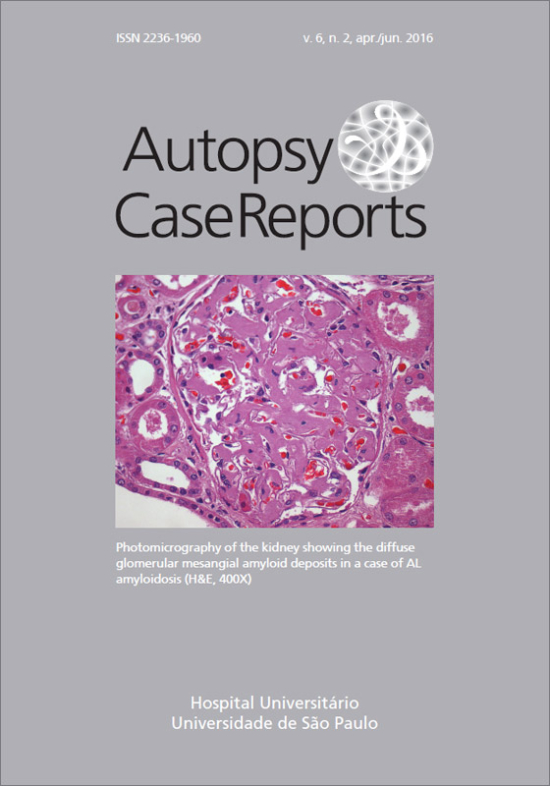Cardiac Myxoma
DOI:
https://doi.org/10.4322/acr.2016.030Keywords:
Heart Neoplasms, MyxomaAbstract
Primary cardiac tumors (PCT) are rare, accounting for 0.0017-0.03% in autopsy series,1,2 in contrast to metastatic tumors of the heart, which are 30 times more frequent.3,4 Nearly 75% of PCT are benign and most often represented by a myxoma in 50% of cases in the adult population.5 The World Health Organization defines a cardiac myxoma (CM) as a neoplasm composed of stellate to plump, cytologically bland, mesenchymal cells set in a myxoid stroma.6 Approximately 95% of CMs occurs isolated in a wide range of age. However, they occur more frequently among women in the fifth or sixth decade of life.7-9 For a time, myxomas were believed to arise from endocardial thrombi10 and some evidence suggests an association with Herpes simplex virus 1 infections11; however, their tumoral histogenesis remains unknown. Meanwhile, ultrastructure analysis—added to immunohistochemical investigation—suggests that CM is more likely derived from a pluripotent mesenchymal stem cell or sub-endothelial cell. Chromosomal clonal abnormalities, mostly on chromosome 2, 12, and 17, appear to be implicated in the myxoma formation, although defects on chromosome 1q32, the loss of the Y chromosome, and the telomeric association of chromosome 13 and 15, have also been involved.12-14 CMs are mostly pedunculated and solitary, and arise primarily adjacent to the lamina of the fossa ovalis (corresponding to the embryonic septum primum) and develop in the left atrium in 75% of cases, followed by the right atrium (18%),15 the right and left ventricles (3% in each), and the valves (1%).15-20 Multiple myxomas represent 5% of the cases, half of which are of bilateral origin.21 Although CM is a benign tumor, reports on its malignancy are well-known, which include: (i) local relapse; (ii) local invasiveness; and (iii) distant metastasis.12 The potential for malignant transformation is controversial, despite the publication of some reports of sarcomas arising from CM recurrences.22,23 Clinical manifestations of CMs are protean and may vary from asymptomatic cases (with a tumor < 4 cm) to unexpected sudden death (generally caused by blood flow obstruction or embolization). In most cases, the clinical presentation will depend on the tumor size, mobility, and location. One or more symptoms of the following triad will usually be present: (i) embolic phenomena (present in 30-40% of cases and usually associated with a villous surface of the tumour)24; (ii) intracardiac flow obstruction (present in almost 50% of cases); and (iii) constitutional symptoms (present in 20-60% of cases). In general, the most common signs and symptoms are non-specific and include dyspnea, palpitation (due to atrial fibrillation), lower limbs edema, hepatomegaly, angina, syncope, cough, and pulmonary edema. The constitutional symptoms, characterized by fatigue, fever, myalgia, arthralgia, and weight loss, are probably related to interleukin-6 cytokine production.25 The diagnosis of a CM is mostly done with echocardiography, both transthoracic and transesophageal, which represent the imaging modality of choice, although the latter permits precise information for the scheduling of surgery. Due to the rarity and consequent unfamiliarity of most general practitioners with this entity, CMs are sometimes misdiagnosed. Differential diagnosis should include intracardiac thrombus and other cardiac tumorsDownloads
Download data is not yet available.
Published
2016-06-11
Issue
Section
Image in focus
License
Copyright
Authors of articles published by Autopsy and Case Report retain the copyright of their work without restrictions, licensing it under the Creative Commons Attribution License - CC-BY, which allows articles to be re-used and re-distributed without restriction, as long as the original work is correctly cited.
How to Cite
Aiello, V. D., & Campos, F. P. F. de. (2016). Cardiac Myxoma. Autopsy and Case Reports, 6(2), 5-7. https://doi.org/10.4322/acr.2016.030



